.
The development of cubism can
be attributed to two men, George Braque and Pablo Picasso. They worked side
by side in the same studio during their cubist period, and their work was
almost indistinguishable. For now, I will consider the development of the
much more famous (and prolific) artist, Picasso.
Pablo Picasso
(Spanish, 1881-1973)

Self Portrait 1899-1900
|
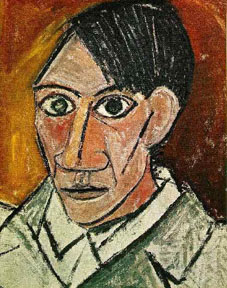
Self Portrait, cubist period
|
See Early Works By Picasso
Blue Period:
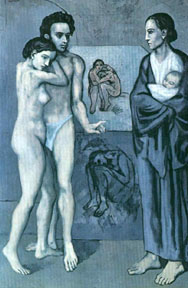
La Vie 1903
|
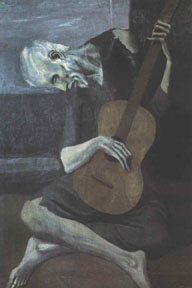
Old Guitarrist 1904
|

Woman with Crow 1904
|
Pablo Picasso was trained to paint
by his father from a very young age, and absorbed his influence as well
as that of the traditions of Spanish art. By his early 20s, he had moved
to Paris, and quickly changed his earth-toned colors to a palette which
was more emotionally expressive. His first truly original works were those
of his Blue period. The young artist was facing some difficult times after
the death of his closest friend, and was also experiencing financial troubles
during his first years in Paris. His paintings of this time were created
in predominantly blue tones, and the images were of immaciated people who
look like they are down on their luck. Despite this, the paintings achieve
a sense of mystery, and these are some of his most poetic images.
Rose Period:
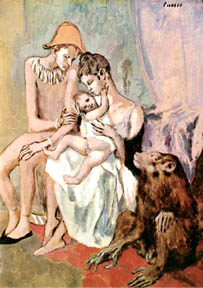
Circus Acrobats and Ape 1905
|
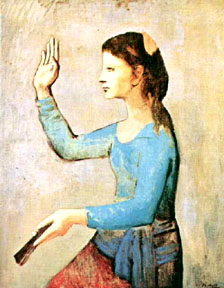
Girl with Fan 1905
|
His blue period only lasted a few
years, and was quickly supplanted with brighter colors when the artist's life
circumstances improved. Collectors started to buy his works, so he was less
financially worried. Also, he is believed to have fallen in love at this time.
Historians call this his Rose period because of the pinks and reds that started
to appear in his works at this time. For some reason, the lives of carnival
people was one of the subjects that was common in these paintings.
Early Cubist Period:
|
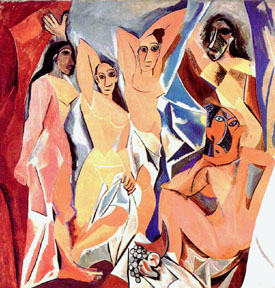
Les Demoiselles de Avignon, 1907
|
|
Les
Demoiselles de Avignon was Picasso's earliest work which broke dramatically
from his figurative and poetic works of the first part of his life. The
painting relates directly to the prostitution district of Paris. The women's
facial features disintegrate into primitive masks, and their bodies are
so hard-edged that it looks as if it would cut you if you touched them.
At this time, Picasso was increasingly influenced by the raw expressive
power of African and Oceanic tribal arts. The women are simultaneously seductive
and horrifying. It
would take a while before this work would become acceptable to even the
most progressive members of artistic circles. But this was the painting
that changed everything for Picasso.
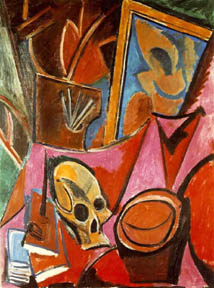
Still Life with Death's Head 1907
|
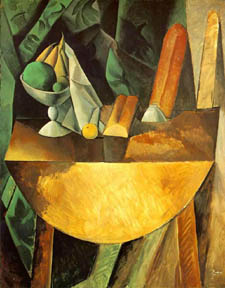
Bread, Fruit and Table 1908
|
By 1907, a collaboration between
Pablo Picasso and Georges Braque was beginning. The two artists worked side
by side, both experimenting with a system which sought to totally flatten
space. One of the primary goals of cubism was to depart from the traditional
understanding of perspective and spacial cues. Their early experiments with
the style uses extremely bright colors, hard edged forms, and flattened
space. Though previous art movements (Impressionism and Post Impressionism)
began to evolve into flatter forms, Picasso and Braque were more radical
in their approach. German Expressionism and Fauvism were going on simultaneously,
and the works of those artists also tended towards flattened pictorial space.
A primary difference between Cubism and those movements is that Cubism is
based much less on the expression of emotion than it is an intellectual
experiment with structure. A specific artist that inspired Picasso's and
Braque's early experiments with this flattened space was Paul Cezanne, whose
canvases tended to defy the logic of space and gravity. The cubists push
the distortion just a little farther, and there are extreme similarities
between the two artists' works.

Picasso: Landscape with Bridge 1909
|
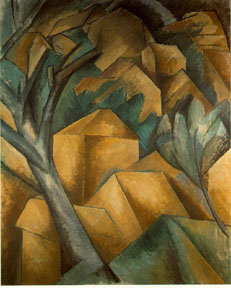
Braque: Houses at La Estaque 1909
|
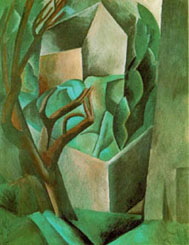
Picasso: Houses with Trees 1907
|
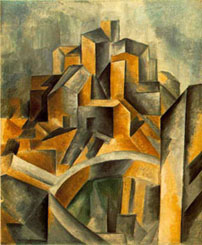
Picasso: Reservoir Horta 1909
|
Analytical Cubism:
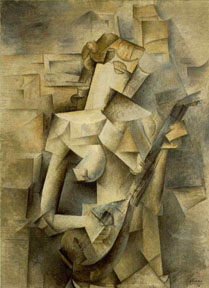
The Mandolin 1910
|
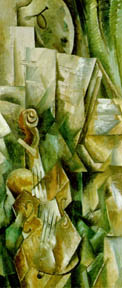
Braque, Violin
|
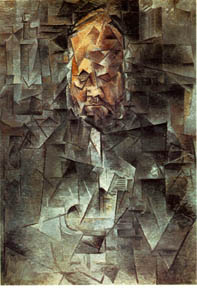
Ambroise Voilard 1910
|
After 1909, Picasso and Braque began a more systematic study of structure
which we know as "Analytical Cubism". In this period, they removed
bright colors from their compositions, favoring monochromatic earth tones
so that they could focus primarily on the structure. The paintings of this
period look as if they have deconstructed objects and rearranged them on
the canvas. One goal of this is to depict different viewpoints simultaneously.
Traditionally, an object is always viewed from one specific viewpoint and
at one specific (stopped) moment in time. Picasso and Braque felt that this
was too limiting, and desired to represent an object as if they are viewing
it from several angles or at different moments in time. Innovative as this
was, the danger was that many of the works of this period are completely
incomprehensible to the viewer, as they start to lose all sense of form.
Synthetic Cubism:
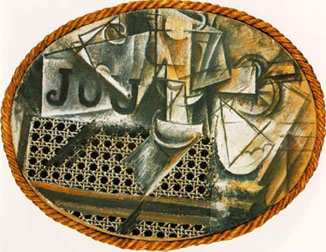 Still Life with Chair Cane
Still Life with Chair Cane 1912 |
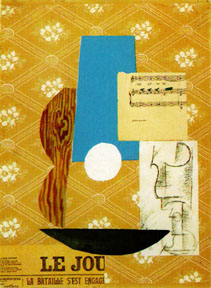
Guitar, Sheet Music and Glass 1912
|
After the artists
had grown tired of the Analytical period, they began to develop what is known
as the Synthetic period. Picasso and Braque continue to introduce new and
controversial changes with the introduction of collaged objects into their
paintings. Still Life with Chair Cane was one of the first of these
experiments, and integrates chair caning with the paint, framed with a length
of rope. Guitar, Sheet Music and Glass includes various collaged papers:
wall paper, a page of sheet music, a drawing of an abstracted glass, and a
newspaper clipping. Incidentally, this clipping includes the headline, "The
battle has begun" (in French), which refers the revolution of representation
the artists are achieving by introducing objects of the real world into their
"paintings". It truly was a revolution which would change the face
of modern art for many years to come.
NeoClassical
Period
(Between the Wars)
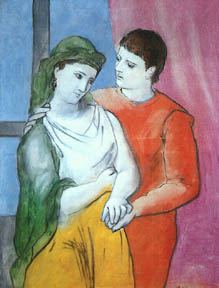
The Lovers 1923
|
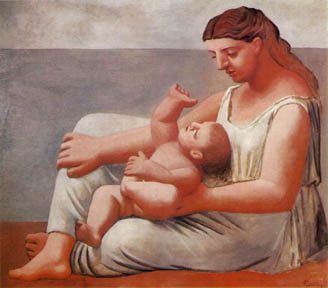
Mother and Child on the Seashore 1921
|
Picasso cannot be accused of sticking
to one style for too long, so if you don't happen to like his cubist period,
other images are perhaps more pleasing to a general public. The collaboration
between Picasso and Braque was ended by the First World War. After this, Picasso
reverted to a more Classicist mode of representation. It is believed that
he did this as a reaction to society's disillusionment and shock from the
horrors of the war. Perhaps, in its own way, it was a way of returning his
own psyche to a state of order and peace. Whatever the reason, this was not
a final stage in Picasso's career. He soon continued to produce cubist works
again, always finding new ways to express himself with the style.
Later Works:
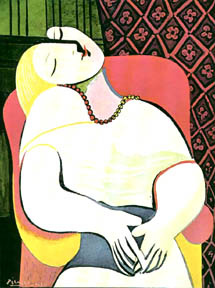
Dream, 1932
|
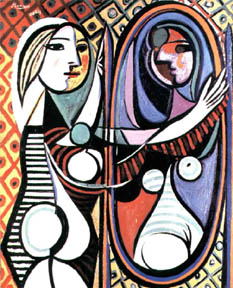
Girl Before a Mirror 1932
|
Picasso's later cubist works
introduce more color and pattern than his experimental earlier period. These
are some of my favorite paintings by Picasso. It is my belief that, at this
point, Picasso and Matisse were influencing each other in their works. The
two artists are described as having "a friendly rivalry".

Guernica, 1937
In 1937, Nazi bombers destroyed
the Spanish Basque town of Guernica, mercilessly killing 1600 unprotected
citizens. The Spanish general, Francisco Franco agreed to let the Nazis
do this in exchange for military aid in the Spanish Civil War. Picasso's
reaction of horror to the
brutal event stimulated his symbolic depiction of "Guernica".
Here he returns to a monochromatic palette in an attempt to suggest the
bleakness of the tragedy, in which 16 miles surrounding surrounding the
entire city was annihilated. Picasso's disturbing painting about the victims
of this senseless act is his cry of protest.
Many other paintings from this period reflect the horror of war, but there
is a consistent depiction of personal interest as well. The women in Picasso's
life had a major impact on his artistic production, and some of the best
examples are from this period. His affection as well as his sometimes terrible
treatment of women was treated in a recent movie called "Surviving
Picasso". The screenplay was developed from a book written by the only
woman to leave Picasso.
|